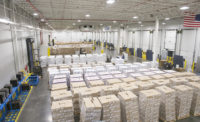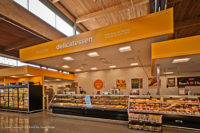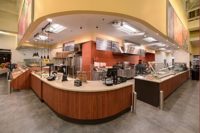With the arrival of waterproof LED technology, the case for making lighting upgrades at The Oppenheimer Group’s British Columbia produce plant dramatically changed. That’s because it stands to save $9,400 a year in energy costs thanks to those upgrades.
Launched in 1858, Oppenheimer originally supplies provisions to gold miners. Today, the company known as “Oppy,” is a fresh produce marketer and distributor that imports more than 100 varieties of fresh fruit and vegetables from more than 25 countries worldwide.
Oppy has sales, marketing and distribution locations throughout North and South America, including in Coquitlam, where the company’s headquarters share space with about 34,000 square feet of warehouse operations.
Replacing metal halide lighting
A few years ago, Russell Watts, Oppy’s facilities coordinator, investigated opportunities for replacing the aging metal halide lamps in the plant’s freezer and six coolers.
The metal halides were inefficient and a maintenance burden, requiring a rented lift for annual lamp replacements as they lost light quality. They also released heat into the cold storage spaces, adding to the electrical load, and their bulky size was accommodated by cutting a hole into the roof of the cold storage rooms, thus reducing insulation value at those points.
However, despite a sustainability mandate and energy conservation goals, the lighting project didn’t make sense. The best alternative was T-5 fluorescents, but the payback period wasn’t adequate to give the project a green light.
But, things change—especially in the constantly-evolving world of industrial lighting.
“LED is becoming more reasonable every day,” says Watts. “Over the past few years, the price has dropped by half. It’s only going to continue to become more cost effective each year because it certainly is very energy efficient and low-maintenance lighting.”
With the help of a business energy advisorand a member of the Power Smart Alliance, a network of energy efficiency trade professionals registered with BC Hydro, Canada, Oppy took another look at options for efficient industrial lighting in the fall of 2014. This time, there was an option for 8-foot, waterproof LED luminaires from G&G LED, Albany, N.Y., that were so efficient that a 70W LED luminaire could replace a 450W metal halide lamp.
Since the LEDs are only about one inch in height, they require little space, allowing the holes in the top of the cold storage rooms to be re-insulated. They also cast off little heat, reducing refrigeration costs.
“In the coolers, they’ve noticed a huge difference,” says Watts. “It used to be very dim; it’s very bright in there now. It’s much easier for the warehouse staff to pick orders because they can see the palletized product on the shelf, so we see better efficiency and an increased safety factor that came out of this project.”
In the warehouse area, the company replaced 43 450W metal halides with the same number of 130W pendant-style LED lamps, giving energy savings that significantly outstripped the T-5 fluorescents it considered a few years ago.
“We’ve severely cut our energy cost in the warehouse, which will pay off over time,” says Watts. “We provided the same level of lighting, if not better, and we’ve reduced our maintenance costs too.”
Oppy’s lighting retrofit is projected to save 102,411 kWh of energy per year, an energy bill reduction of about $9,400. With a $21,388 incentive from the Self-serve Incentive Program, which covers up to 75% of project costs, the payback period was less than four years. If the calculation includes cost-savings on maintenance, heat loss in the coolers and reduced refrigeration load, Watts says the payback period is closer to three years.
Watts says he’d encourage any company that hasn’t recently investigated options for efficient lighting to check whether they’re missing out on savings.
“BC Hydro and their Power Smart Alliance partners supported us through the entire project to make sure it became a success,” he says. “I always felt like I knew what was going on, and they helped us get our rebate in a timely manner. It’s obviously a very worthwhile exercise to find out who your business energy advisor is and have them look at your situation and see what’s available to you. It’s not like you have to spend hours self-researching the options; these people know their products and they make it easy for the customer. Don’t make assumptions about what a project might cost. If you don’t ask the question, you’re never going to know what you could save.”



